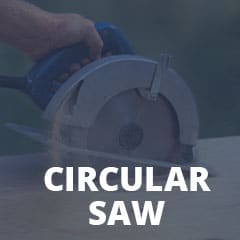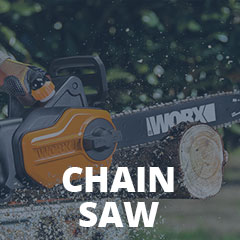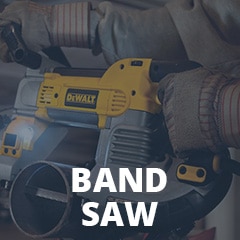
If you need to trim, cut, or prune high-level branches, limbs, or vines — it’s valuable to understand how to use a pole saw.
Sure, you could carry your beefiest chainsaw up an extending ladder, overstretch precariously, and hack away while trying to maintain your balance. But, I wouldn’t advise it — unless you want to look like Leatherface from The Texas Chainsaw Massacre (1974).
Safety is crucial — that’s why it’s important for me to pass on my experience and knowledge of risk-free pole saw use. Thus, allowing you to achieve results worthy of a pro arborist — where the only cut-off limbs are those of the tree.
What You Will Need to Follow This Tutorial
With your mighty tool in your hand, it’s natural to want to power away immediately.
But, don’t be premature.
Taking it slow and steady, and preparing thoroughly beforehand, will provide a more satisfying and pleasurable finish, save you time, and heighten safety.
Check you have all the below items before commencing your lopping, pollarding, or coppicing project:
-
- Pole saw.
- Extension cord — if using a cabled pole saw.
- Additional power cells — when wielding a cordless unit.
- Spare fuel — if utilizing a gas-powered machine.
- Pencil and paper for plan sketching.
- Cones, ropes, tape, or spray paint — to cordon off the cutting area.
- Chain oil — or SAE 30 weight motor oil.
- Eye protectors.
- Face mask.
- Gloves.
- Steel toe-capped boots.
- Ear defenders.
- Hard-hat.
- Dry, non-windy, weather conditions.
- Rake, barrow, or buddy for cleaning up.
How to Use a Pole Chain Saw — Step By Step Instructions
Step 1 — Precautions
Safe tree-trimming is akin to safe sex — without the proper precautions, it will be messy, dangerous to health, and lead to years of regret. To avoid these pitfalls, follow my six golden rules:3. Bear in mind, it’s challenging to achieve the perfect cut on seriously thick branches with a pole saw. Anything greater than seven or nine inches in diameter should be addressed with a chainsaw — or by a professional.
5. Familiarize yourself with the jump-cutting technique — explained below — allowing the cut limbs and branches to separate from the tree without tearing the living flesh, and aiding it to fall in your chosen direction — not on your head.


Step 2 — Prepare Your Work Area
Step 3 — Prepare Your Pole Saw
Step 4 — Protect Yourself
-
- Eye protectors.
- Face mask.
- Gloves.
- Steel toe-capped boots.
- Ear defenders.
- Hard-hat.
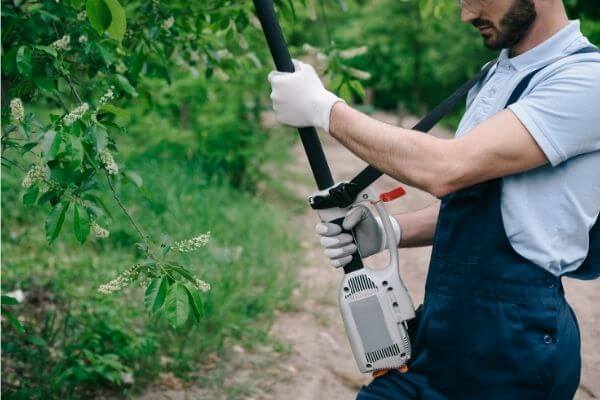
Step 5 — Assume the Correct Cutting Position
17. If possible, use a pole-saw support harness for additional stability.
Step 6 — Cutting Branches and Limbs With the Pole Saw
25. With thin branches removed (as in point 22, above), it’s time to proceed with the jump-cutting process — reducing the size, and therefore weight, of the limb. Starting at the end of the limb, repeatedly cut off sections of around two to three feet — always making the cut just above a node.
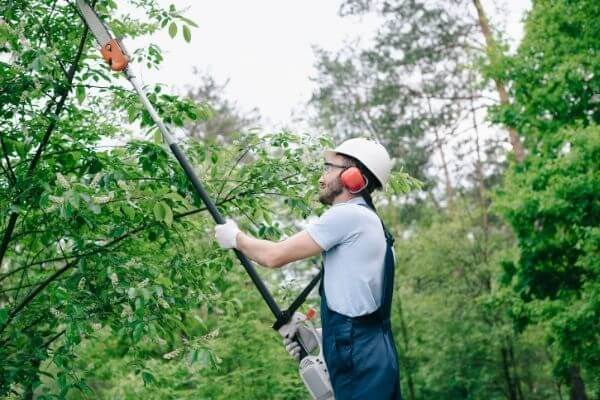
Step 7 — The Clean-Up
Additional Tips For Using a Pole Saw
On top of the techniques and safety advice outlined above, here are my bonus tips to become a true pole saw aficionado:
-
- Keep the pole and handle free from oil.
- Ensure the chain stops completely before putting the machine down.
- Only have your unit repaired by a qualified tool engineer.
- Don’t overreach.
- For added safety — use a reduced-kickback chain and guard.
- Cut one branch at a time — it’s not a race.
- Have frequent comfort breaks — it’s nice to get away from the noise and vibration.
- Don’t touch the chain while it is moving.
- If you need to touch the blade to check tension — wear gloves.
The Final Cut
With preparation, planning, and patience — your pole saw cuts the parts other saws cannot reach.
I consider understanding pole saw use to be an invaluable skill for the ardent home gardener — allowing you to lop, dock, and shape your tree while keeping two feet planted safely on the ground.
I really hope you enjoyed this walkthrough — and, if you think one of your arboreal-loving buddies would benefit from checking it out, please feel free to share.
Now you know the tricks behind how to use a pole saw — so get outside and prune like a pro.







